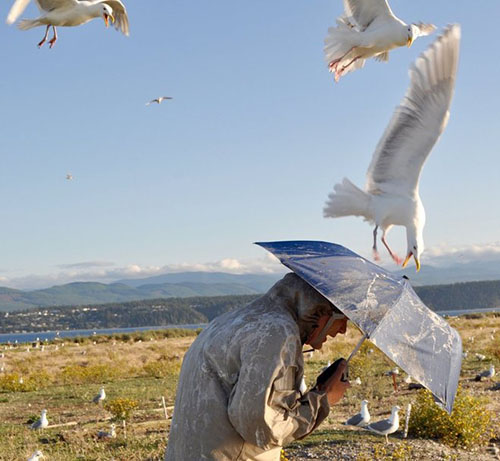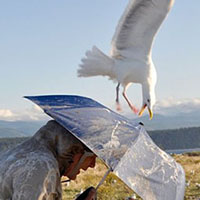— by Tristan Baurick, Kitsap Sun —

Biologist Jim Hayward shields himself with an umbrella while visiting a large gull nesting colony on Protection Island, a wildlife refuge in the Strait of Juan de Fuca. Hayward’s research has found that climate change is triggering cannibalism among nesting gulls. Tristan Baurick/Kitsap Sun
PROTECTION ISLAND — Jim Hayward slips on a hard hat and pops open an umbrella before stepping into a storm of angry gulls.
Hayward, a seabird biologist based on Protection Island in the Strait of Juan de Fuca, is making his evening rounds through the largest gull nesting colony in the Puget Sound region. He’s been monitoring this site since 1987, so he’s used to the shrieking, the divebombing, the frequent splatterings of gull poop, and the pecking at his head, hands and feet.
What he’s not accustomed to is the cannibalism. It’s hard to watch: a fluffy chick straying a few yards from its nest is suddenly snatched up by its neck. Another hungry gull swoops in and bites at the chick’s leg. The mother intervenes but is outnumbered. Her baby disappears under a frenzy of flapping and pecking.
Over the last decade, the gulls have shown a growing taste for their neighbors’ eggs and chicks. The trend appears linked to climate change.
“It doesn’t seem like a lot, but a one-tenth of a degree change in seawater temperature correlates to a 10 percent increase in (the odds of) cannibalism,” said Hayward, a professor at Andrews University in Michigan.
Over the past 60 years, ocean temperatures have increased about 15 times faster than any other time over the past 10,000 years. As temperatures rise, plankton drops into deeper, colder water. Fish that feed on the plankton also drop lower. The surface-feeding gulls, which depend almost entirely on fish while nesting on Protection Island, can’t find enough to eat.
“So they resort to feeding on their neighbors,” Hayward said.
READ MORE AT SOURCE: Kitsap Sun
**If you are reading theOrcasonian for free, thank your fellow islanders. If you would like to support theOrcasonian CLICK HERE to set your modestly-priced, voluntary subscription. Otherwise, no worries; we’re happy to share with you.**








